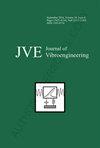Optimization of communication performance in wireless seismic monitoring system
IF 0.9
Q4 ENGINEERING, MECHANICAL
引用次数: 0
Abstract
In order to improve the communication performance between different equipment in the seismic detection system, a wireless network system with MIMO (Multiple Input and Multiple Output) characteristics was designed and applied in the paper. On the basis of 5G communication, a new data conversion and transmission model was built, which can improve the rate of signal transmission and reduce the bit error rate and power consumption. For the purpose of power optimization, the overall framework of the network system was improved, of which power characteristics and performance were verified. The conjugate beam was normalized, and the cumulative distribution function under different downlink rates was obtained based on the maximum minimum power control scheme. In order to verify the energy-saving effect of the design, the ADC (Analog-to-Digital Conversion) power model is introduced. Through simulation analysis, the change rules of spectrum efficiency and energy efficiency under different network nodes were obtained. The results show that the normalized conjugate beam can be less affected by the transmission nodes, and the power control is more reliable under the same conditions. The research and application of this subject can significantly improve the wireless communication performance of the seismic monitoring system, reduce the power consumption of network equipment, improve the data transmission efficiency, and provide strong technical support for seismic prediction and data analysis. Through the test of artificial earthquake, it is verified that the communication scheme designed in this paper has higher transmission efficiency and lower bit error rate, and is very suitable for the long-distance transmission of seismic signals.无线地震监测系统中通信性能的优化
为了提高地震探测系统中不同设备之间的通信性能,本文设计并应用了一种具有MIMO(多输入多输出)特性的无线网络系统。在5G通信的基础上,建立了一种新的数据转换和传输模型,可以提高信号传输速率,降低误码率和功耗。为了进行功率优化,对网络系统的总体框架进行了改进,验证了网络系统的功率特性和性能。基于最大最小功率控制方案,对共轭波束进行了归一化,得到了不同下行速率下的累积分布函数。为了验证设计的节能效果,介绍了ADC(模数转换)功率模型。通过仿真分析,得出了不同网络节点下频谱效率和能量效率的变化规律。结果表明,在相同条件下,归一化共轭波束受传输节点的影响较小,功率控制更可靠。该课题的研究和应用可以显著提高地震监测系统的无线通信性能,降低网络设备的功耗,提高数据传输效率,为地震预报和数据分析提供强有力的技术支持。通过人工地震的测试,验证了本文设计的通信方案具有较高的传输效率和较低的误码率,非常适合地震信号的远距离传输。
本文章由计算机程序翻译,如有差异,请以英文原文为准。
求助全文
约1分钟内获得全文
求助全文
来源期刊

Journal of Vibroengineering
工程技术-工程:机械
CiteScore
1.70
自引率
0.00%
发文量
97
审稿时长
4.5 months
期刊介绍:
Journal of VIBROENGINEERING (JVE) ISSN 1392-8716 is a prestigious peer reviewed International Journal specializing in theoretical and practical aspects of Vibration Engineering. It is indexed in ESCI and other major databases. Published every 1.5 months (8 times yearly), the journal attracts attention from the International Engineering Community.
 求助内容:
求助内容: 应助结果提醒方式:
应助结果提醒方式:


